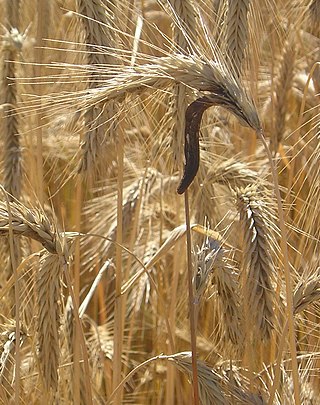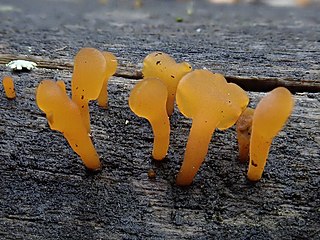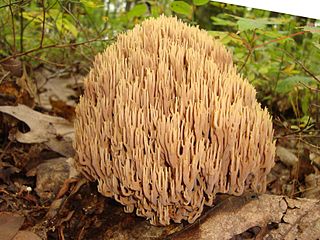
Boletus edulis is a basidiomycete fungus, and the type species of the genus Boletus. Widely distributed in the Northern Hemisphere across Europe, Asia, and North America, it does not occur naturally in the Southern Hemisphere, although it has been introduced to southern Africa, Australia, New Zealand, and Brazil. Several closely related European mushrooms formerly thought to be varieties or forms of B. edulis have been shown using molecular phylogenetic analysis to be distinct species, and others previously classed as separate species are conspecific with this species. The western North American species commonly known as the California king bolete is a large, darker-coloured variant first formally identified in 2007.

Pleurotus ostreatus, the oyster mushroom, oyster fungus, hiratake, or pearl oyster mushroom is a common edible mushroom. It is one of the more commonly sought wild mushrooms, though it can also be cultivated on straw and other media.

Suillus luteus is a bolete fungus, and the type species of the genus Suillus. A common fungus native all across Eurasia from Ireland to Korea, it has been introduced widely elsewhere, including North and South America, southern Africa, Australia and New Zealand. Commonly referred to as slippery jack or sticky bun in English-speaking countries, its names refer to the brown cap, which is characteristically slimy in wet conditions. The fungus, initially described as Boletus luteus by Carl Linnaeus in 1753, is now classified in a different fungus family as well as genus. Suillus luteus is edible, though not as highly regarded as other bolete mushrooms. It is commonly prepared and eaten in soups, stews or fried dishes. The slime coating, however, may cause indigestion if not removed before eating. It is often sold as a dried mushroom.

A sclerotium, is a compact mass of hardened fungal mycelium containing food reserves. One role of sclerotia is to survive environmental extremes. In some higher fungi such as ergot, sclerotia become detached and remain dormant until favorable growth conditions return. Sclerotia initially were mistaken for individual organisms and described as separate species until Louis René Tulasne proved in 1853 that sclerotia are only a stage in the life cycle of some fungi. Further investigation showed that this stage appears in many fungi belonging to many diverse groups. Sclerotia are important in the understanding of the life cycle and reproduction of fungi, as a food source, as medicine, and in agricultural blight management.

Eupomatia laurina, commonly named bolwarra, native guava or copper laurel, is a species of plant in the primitive flowering-plant family Eupomatiaceae, endemic to Australia and New Guinea. It grows to between 3 and 5 m tall, but larger specimens may attain a height of 15 m (50 ft) and a trunk diameter of 30 cm (12 in). In Australia, it is found in humid forests of the east coast, from as far south as Nowa Nowa in Victoria, north through New South Wales and Queensland to tropical Cape York Peninsula. It usually grows as an understorey plant in rainforests or humid Eucalypt forests.

Ganoderma applanatum is a bracket fungus with a cosmopolitan distribution.

Dacryopinax spathularia is a species of fungus in the family Dacrymycetaceae. Basidiocarps are gelatinous, frequently spathulate (spoon-shaped), and grow on wood, mainly in the tropics and subtropics. The fungus is edible and is commercially cultivated for use as an additive in the food industry.

Omphalotus nidiformis, or ghost fungus, is a gilled basidiomycete mushroom most notable for its bioluminescent properties. It is known to be found primarily in southern Australia and Tasmania, but was reported from India in 2012 and 2018. The fan or funnel shaped fruit bodies are up to 30 cm (12 in) across, with cream-coloured caps overlain with shades of orange, brown, purple, or bluish-black. The white or cream gills run down the length of the stipe, which is up to 8 cm (3 in) long and tapers in thickness to the base. The fungus is both saprotrophic and parasitic, and its fruit bodies are generally found growing in overlapping clusters on a wide variety of dead or dying trees.

Turbinellus floccosus, commonly known as the scaly vase, or sometimes the shaggy, scaly, or woolly chanterelle, is a cantharelloid mushroom of the family Gomphaceae native to Asia and North America. It was known as Gomphus floccosus until 2011, when it was found to be only distantly related to the genus's type species, G. clavatus. It was consequently transferred from Gomphus to Turbinellus. The orange-capped vase- or trumpet-shaped fruiting bodies may reach 30 cm (12 in) high and 30 cm (12 in) wide. The lower surface, the hymenium, is covered in wrinkles and ridges rather than gills or pores, and is pale buff or yellowish to whitish.

Xerocomus subtomentosus, commonly known as suede bolete, brown and yellow bolete , boring brown bolete or yellow-cracked bolete, is a species of bolete fungus in the family Boletaceae. The fungus was initially described by Carl Linnaeus in 1753 and known for many years as Boletus subtomentosus. It is edible, though not as highly regarded as other bolete mushrooms.

Macrolepiota clelandii, commonly known as the slender parasol or graceful parasol, is a species of mushroom-forming fungus in the family Agaricaceae. The species is found in Australia and New Zealand, where it fruits singly or in small groups on the ground in eucalypt woodlands, parks, and roadsides. It is a tall mushroom up to roughly 20 cm (8 in), with a broad cap covered with distinctive rings of dark brown scales. The whitish gills on the cap underside are closely spaced and free from attachment to the slender stipe, which has a loose ring on its upper half, and a bulbous base. The edibility of the mushroom is not known with certainty, but closely related parasol mushrooms are edible and some are very sought after.

Grifola frondosa is a polypore mushroom that grows at the base of trees, particularly old growth oaks or maples. It is typically found in late summer to early autumn. It is native to China, Europe, and North America.

Exsudoporus frostii, commonly known as Frost's bolete or the apple bolete, is a bolete fungus first described scientifically in 1874. A member of the family Boletaceae, the mushrooms produced by the fungus have tubes and pores instead of gills on the underside of their caps. Exsudoporus frostii is distributed in the eastern United States from Maine to Georgia, and in the southwest from Arizona extending south to Mexico and Costa Rica. A mycorrhizal species, its fruit bodies are typically found growing near hardwood trees, especially oak.

Mycena sanguinolenta, commonly known as the bleeding bonnet, the smaller bleeding Mycena, or the terrestrial bleeding Mycena, is a species of mushroom in the family Mycenaceae. It is a common and widely distributed species, and has been found in North America, Europe, Australia, and Asia. The fungus produces reddish-brown to reddish-purple fruit bodies with conic to bell-shaped caps up to 1.5 cm (0.6 in) wide held by slender stipes up to 6 cm (2.4 in) high. When fresh, the fruit bodies will "bleed" a dark reddish-purple sap. The similar Mycena haematopus is larger, and grows on decaying wood, usually in clumps. M. sanguinolenta contains alkaloid pigments that are unique to the species, may produce an antifungal compound, and is bioluminescent. The edibility of the mushroom has not been determined.

Suillus pungens, commonly known as the pungent slippery jack or the pungent suillus, is a species of fungus in the genus Suillus. The fruit bodies of the fungus have slimy convex caps up to 14 cm (5.5 in) wide. The mushroom is characterized by the very distinct color changes that occur in the cap throughout development. Typically, the young cap is whitish, later becoming grayish-olive to reddish-brown or a mottled combination of these colors. The mushroom has a dotted stem (stipe) up to 7 cm (2.8 in) long, and 2 cm (0.8 in) thick. On the underside on the cap is the spore-bearing tissue consisting of minute vertically arranged tubes that appear as a surface of angular, yellowish pores. The presence of milky droplets on the pore surface of young individuals, especially in humid environments, is a characteristic feature of this species. S. pungens can usually be distinguished from other similar Suillus species by differences in distribution, odor and taste. The mushroom is considered edible, but not highly regarded.

Mycena aurantiomarginata, commonly known as the golden-edge bonnet, is a species of agaric fungus in the family Mycenaceae. First formally described in 1803, it was given its current name in 1872. Widely distributed, it is common in Europe and North America, and has also been collected in North Africa, Central America, and Japan. The fungus is saprobic, and produces fruit bodies (mushrooms) that grow on the floor of coniferous forests. The mushrooms have a bell-shaped to conical cap up to 2 cm in diameter, set atop a slender stipe up to 6 cm long with yellow to orange hairs at the base. The fungus is named after its characteristic bright orange gill edges. A microscopic characteristic is the club-shaped cystidia that are covered with numerous spiky projections, resembling a mace. The edibility of the mushroom has not been determined. M. aurantiomarginata can be distinguished from similar Mycena species by differences in size, color, and substrate. A 2010 publication reported the discovery and characterization of a novel pigment named mycenaaurin A, isolated from the mushroom. The pigment is responsible for its color, and it has antibiotic activity that may function to prevent certain bacteria from growing on the mushroom.

Hygrophorus marzuolus, commonly known as the March mushroom, is a species of fungus in the family Hygrophoraceae. It is known from Asia, Europe, and North America, where it grows on the ground in mixed forests at high elevations.

Morchella rufobrunnea, commonly known as the blushing morel, is a species of ascomycete fungus in the family Morchellaceae. A choice edible species, the fungus was described as new to science in 1998 by mycologists Gastón Guzmán and Fidel Tapia from collections made in Veracruz, Mexico. Its distribution was later revealed to be far more widespread after several DNA studies suggested that it is also present in the West Coast of the United States, Israel, Australia, Cyprus, Malta and Switzerland.

Cortinarius camphoratus, commonly known as the goatcheese webcap, is an agaric fungus in the family Cortinariaceae. The fungus is found in Europe and North America, where its fruit bodies (mushrooms) grow on the ground in a mycorrhizal association with spruce and firs in coniferous forests. Mushrooms are characterized by pale blue lilac colors when young, and a strong distinctive odor. Sources disagree as to the edibility of the mushroom, but they are generally not recommended for eating.

Ramaria stricta, commonly known as the strict-branch coral is a coral fungus of the genus Ramaria. It has a cosmopolitan distribution, and grows on dead wood, stumps, trunks, and branches of both deciduous and coniferous trees. Its fruit body is up to 10 cm tall, made of multiple slender, compact, and vertical parallel branches. Its color is typically light tan to vinaceous-brown. All parts of the mushroom will bruise when handled. There are several lookalike corals that can usually be distinguished from R. stricta by differences in coloration, bruising reaction, or microscopic features. The fungus is inedible due to its unpleasant odor and bitter taste.




















